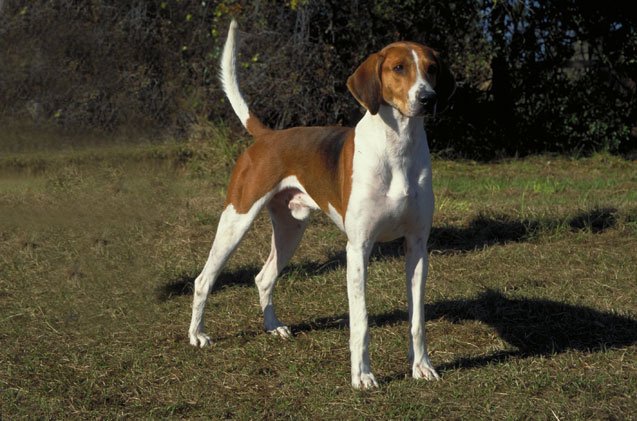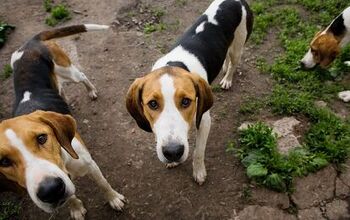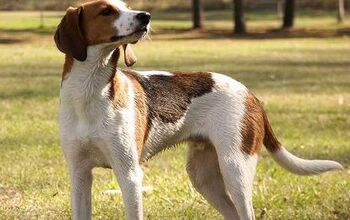American Foxhound


About American Foxhound
The American Foxhound, also known as the Foxhound, is all-American – it’s one of the only breeds that truly originated in the United States. In fact, the state of Virginia made the American Foxhound its official state dog in 1966. Not only that, the American Foxhound is also one of the rarest breeds. Although in the past, the Foxhound hasn’t been considered a house pet, this dog may fit into your household, as it is well mannered and amiable.
The American Foxhound is a natural hunter – this dog will go after a scent and won’t listen to commands. An active breed, the Foxhound loves the outdoors and is up for any type of exercise. This breed isn’t suited for city life, as it needs plenty of space to run around. Typical of hound breeds, the American Foxhound doesn’t like to be left alone for long periods of time. If you’re active, live alone, enjoy the outdoors, have a family and are an experienced dog handler, the American Foxhound will be the dog for you.
The American Foxhound, also known as the Foxhound, is all-American – it’s one of the only breeds that truly originated in the United States.
Developed from a line of hounds in 1650, American Foxhounds were the result of careful breeding by Robert Brooke. Bringing them from England to the US, Brooke eventually created a breeding and working pack of black-and-tan foxhounds. These Foxhounds are said to be the foundation for the Black and Tan Coonhound, another American original. In early 18th century, Foxhounds made its way to Virginia. In fact, George Washington received a pack of foxhounds as a gift in the mid-1700s. Washington was a huge fan of the breed – he kept, bred and hunted American Foxhounds. As well, he maintained detailed records and pedigrees that established some of the best early examples of the American Foxhound. In 1785, after acquiring several large French Hounds, Washington used these imports to increase the size of his American Foxhounds. For increased speed, the American Foxhound was bred with hounds from Ireland in the 1830s.
The American Foxhound was developed specifically to hunt American grey and red foxes in open fields, woodlands and river valleys. But there were a few problems – the grey fox moved slowly, and the red fox was uncommon in the eastern United States, a popular place for foxhunting. To combat these issues, English red foxes were imported for a sporting chase. Over time, the English foxes inbred with the US foxes, creating a faster native fox.
Pedigree
Developed by the wealthy for sport hunting, the American Foxhound is descended from English hounds brought to America in 1650. A century later, these dogs were mixed with French hounds.
Select a dry dog food with high-quality meat ingredients, protein levels and higher fat content. Try to stay away from dog foods that list soy or corn products as one of the first five ingredients. These are safe ingredients for a dog, but the American Foxhound is an active breed and it will need higher quality nutrition to keep up its energy level.
An active breed, the Foxhound loves the outdoors and is up for any type of exercise.
Because it is a type of hound, you’ll find that the Foxhound is moderately easy to train. But because every dog is different, your American Foxhound may be easier or more difficult to train. Like any dog, the American Foxhound’s attention span is short, so keep training sessions short. Make sure that sessions are not overly repetitive and be calm and patient when teaching any skill. If you speak harshly to your Foxhound, it will avoid training and may lead to stubbornness. After tackling the basics with your dog and establishing leadership and trust, enroll your Foxhound in advanced obedience, agility and tracking classes.
American Foxhounds generally weigh anywhere from 40 to 60 pounds.
Temperament / Behavior
If your family is active and loves the outdoors, the American Foxhound is the dog for you. They need lots of room to run – more than an average backyard – so it thrives in a rural environment. If you let them, Foxhounds will move all day long, which makes it important to have the room outdoors. This breed gets along great with kids and other dogs (if possible, should be raised alongside other dogs), but not so much with cats. After a long day of hunting, the American Foxhound will have enough energy to play with the kids.
Part of its hound dog nature, American Foxhounds love to bay and howl, especially at night and when left alone. This isn’t a behavior that can be trained out of them.
Separation anxiety is an issue with the American Foxhound, especially if it isn’t properly exercised. When left alone and bored, there’s no telling what it will do. That’s why you should make sure there are plenty of things to do for your dog. And other companion dogs to keep your Foxhound company will also help.
The American Foxhound is generally a healthy breed, however, some health concerns may include congenital deafness, ear infections, hip dysplasia, Pelger-Huet anomoly and thrombocytopathy (disorders of the blood platelet and abnormal functioning of the platelets).
A relatively healthy breed, the American Foxhound has an average lifespan of 11 to 12 years.
We’ve mentioned it before, but we’ll say it again – the American Foxhound needs lots of exercise. This breed was made for hunting and boasts superior stamina, with a seemingly never-ending energy reserve. There’s no leisurely stroll for this dog – you have to give your Foxhound at least one vigorous hour of exercise a day. If you’re not a hunter, don’t participate in outdoor activities, or live in an apartment or condo, this is not the breed for you. If a Foxhound doesn’t get enough exercise, it will become destructive behavior, bay and howl and exhibit neurotic tendencies.
Hunters will love the American Foxhound. A hard-working hunting dog, this breed can be used as a tracker in the field. Just like the Energizer Bunny, the Foxhound will keep going and going for hours without become tired. Once they catch a scent, they will follow it without distraction. When not being used for hunting, the American Foxhound should be kept in a fenced-in area or on a leash.
The Foxhound isn’t a lone wolf, so to speak. It loves people and other dogs. The more, the merrier – bring home a couple of dogs to keep the American Foxhound company.
Part of its hound dog nature, American Foxhounds love to bay and howl, especially at night and when left alone.
The American Kennel Association says this about the breed: “One of America’s native breeds, the American Foxhound is also one of our rarest. This tall hound sports a close, hard coat that can be any color. The Foxhound in this country is used for four purposes, thus calling for hounds of a different characteristics: competitive field trial hounds and “trail” hounds (speed is most important), fox hunting hounds (slow workers with good voices), and pack hounds (15 to 20 hounds or more, used by hunt clubs and farmers).” The AKC first recognized this breed in 1886.
Sporting a hard-textured, medium length coat that lies close to the body, the American Foxhound is protected from briars, burrs and brush encountered while hunting. Coat color doesn’t matter when it comes to breed standard and it comes in many colors. All colors and markings are acceptable.
Grooming the American Foxhound is easy. This breed sheds lightly year round, so a regular weekly brushing is recommended to keep loose hair under control. You won’t have to bathe your dog very often, only when the Foxhound is dirty or begins to smell.
Training and socializing your American Foxhound should start early. These are smart dogs that will pick up the basics quickly.

Amy Tokic, Editor of PetGuide.com, is a passionate animal lover and proud pet parent of Oscar, a Shih Tzu/Chihuahua cross, and Zed, a Japanese Chin. Her love of animals began in kindergarten, when she brought her stuffed dog Snoopy into class with her every day. Now, she writes about her adventures in pet ownership and tirelessly researches products, news and health related issues she can share with other animal enthusiasts. In her free time, Amy loves perusing used book and record stores, obsessing over the latest pet products available and chasing squirrels with wild abandon (a habit attributed to spending too much time with her pooches).
More by Amy Tokic

























